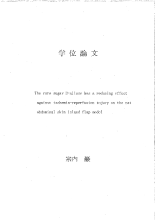The rare sugar D-allose has a reducing effect against ischemia-reperfusion injury on the rat abdominal skin island flap model
Access this Article
Author
Bibliographic Information
- Title
-
The rare sugar D-allose has a reducing effect against ischemia-reperfusion injury on the rat abdominal skin island flap model
- Author
-
宗内, 巌
- University
-
香川大学
- Types of degree
-
博士(医学)
- Grant ID
-
乙第267号
- Degree year
-
2013-12-18
Note and Description
BackgroundRecently, one of the rare sugars, D-allose, has received attention from many researchers because of its availability for mass production and its various physiological functions. Among these, an antioxidative effect has been strongly suggested. In this study, we investigated whether this effect is also applicable to the field of skin surgery.
MethodsIn ischemia-reperfusion injury model using the rat abdominal skin island flap (male Wistar rats, n = 110), D-allose was injected intravenously 15 min before 8-h ischemia. The survival area (%) was measured by digital photographic assessment 1 wk after surgery, and multiple comparisons (Fisher's protected least significant difference) were carried out. Histopathological examination (neutrophilic infiltration into dermis in hematoxylin and eosin stain) and immunostaining (of ectodermal dysplasia-1 (ED1)-positive cells/flap) were assessed. Myeloperoxidase (MPO) activity in the skin flap (sampling at the time of 8 h after reperfusion) was measured spectrophotometrically, and Student t-test was performed.
ResultsD-allose extended the survival of the remaining flaps, and a dose greater than 30 mg (0.1 mg/g) was necessary to be effective. The flap survival rates in the 30, 60, and 150 mg groups were significantly higher than that in the control (saline) group: 75.87 ± 5.90, 79.27 ± 7.81, and 77.87 ± 6.20 versus 50.53 ± 9.66, respectively (P < 0.05). ED1-positive cells/flap in 60 mg of D-allose and control (saline) were 78 ± 25.7 versus 124 ± 15.8, respectively (P = 0.08). The MPO activity in the D-allose 60 mg group was 0.40 ± 0.04, and that in the control (saline) was 0.72 ± 0.12. D-allose significantly reduced the skin tissue MPO activity (P < 0.05) compared with that in the control (saline) group.
ConclusionsWe proved that D-allose has a reducing effect against ischemia-reperfusion injury on the skin island flap model, and the mechanism is related to inhibiting the activity of neutrophils in the skin tissues. Compared with chemo-synthetic materials, rare sugars are safer for our bodies as well as the environment; therefore, this rare sugar project is expected to lead to the development of a safer antioxidant for skin flap surgery.
Background Recently, one of the rare sugars, D-allose, has received attention from many researchers because of its availability for mass production and its various physiological functions. Among these, an antioxidative effect has been strongly suggested. In this study, we investigated whether this effect is also applicable to the field of skin surgery.
Methods In ischemia-reperfusion injury model using the rat abdominal skin island flap (male Wistar rats, n = 110), D-allose was injected intravenously 15 min before 8-h ischemia. The survival area (%) was measured by digital photographic assessment 1 wk after surgery, and multiple comparisons (Fisher's protected least significant difference) were carried out. Histopathological examination (neutrophilic infiltration into dermis in hematoxylin and eosin stain) and immunostaining (of ectodermal dysplasia-1 (ED1)-positive cells/flap) were assessed. Myeloperoxidase (MPO) activity in the skin flap (sampling at the time of 8 h after reperfusion) was measured spectrophotometrically, and Student t-test was performed.
Results D-allose extended the survival of the remaining flaps, and a dose greater than 30 mg (0.1 mg/g) was necessary to be effective. The flap survival rates in the 30, 60, and 150 mg groups were significantly higher than that in the control (saline) group: 75.87 ± 5.90, 79.27 ± 7.81, and 77.87 ± 6.20 versus 50.53 ± 9.66, respectively (P < 0.05). ED1-positive cells/flap in 60 mg of D-allose and control (saline) were 78 ± 25.7 versus 124 ± 15.8, respectively (P = 0.08). The MPO activity in the D-allose 60 mg group was 0.40 ± 0.04, and that in the control (saline) was 0.72 ± 0.12. D-allose significantly reduced the skin tissue MPO activity (P < 0.05) compared with that in the control (saline) group.
Conclusions We proved that D-allose has a reducing effect against ischemia-reperfusion injury on the skin island flap model, and the mechanism is related to inhibiting the activity of neutrophils in the skin tissues. Compared with chemo-synthetic materials, rare sugars are safer for our bodies as well as the environment; therefore, this rare sugar project is expected to lead to the development of a safer antioxidant for skin flap surgery.


